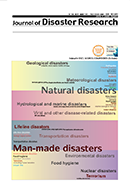
- |<
- <
- 1
- >
- >|
-
Santiago Pujol, Lucas Laughery, Aishwarya Puranam, Pedram Hesam, Li-Hu ...Article type: Paper
2020 Volume 15 Issue 1 Pages 9-19
Published: February 01, 2020
Released on J-STAGE: February 01, 2020
JOURNAL OPEN ACCESSCommunities need seismic vulnerability indices to identify which buildings are most susceptible to severe damage during earthquakes. To be of greatest value, these indices should be easy to use and should be vetted against data from previous earthquakes. To date, more than 800 reinforced concrete buildings have been surveyed after earthquakes for the purpose of evaluating a seismic vulnerability index proposed by Hassan and Sozen in 1997. This number includes 130 buildings surveyed after the 6 February 2016 earthquake in Taiwan. The data collected during these surveys consist of descriptions and photographs of damage, structural sketches, and measurements. Analyses of the data indicate that probability of severe damage and failure increases with decreasing column index and wall index (normalized measures of column and wall areas). They also suggest that the exact form of the threshold used to distinguish more vulnerable structures from less vulnerable structures is of little consequence in terms of the probable cost and benefits of the strengthening program this threshold may inform.
View full abstractDownload PDF (2880K) -
Toshimitsu Nagata, Reo KimuraArticle type: Paper
2020 Volume 15 Issue 1 Pages 20-40
Published: February 01, 2020
Released on J-STAGE: February 01, 2020
JOURNAL OPEN ACCESSIn this study, we first discuss the current status and issues of disaster management education in the context of special support education in Japan, in view of the casualties of those with disabilities during major past earthquakes in Japan. We highlight that there are very few examples of practical implementation of, instructional material for, or previous studies on disaster management education for disabled children, or an established systematic instructional method. As a result, disaster management education tailored to the specific type of disability has been implemented on a school-to-school basis among Special Support Schools for children with disabilities. In many cases, teacher-led evacuation drills have been considered disaster management education. This is an indication that the disaster management education currently practiced in Special Support Schools is inadequate to achieve the goal of “fostering the attitude of acting on one’s initiative” as set forth by the Ministry of Education, Culture, Sports, Science and Technology (MEXT). In view of the situation in Japan, where casualties due to natural disasters continue to occur frequently since the Great East Japan Earthquake, it is urgent that we promote practical disaster management education to foster the Zest for Life among disabled children. This paper is a case study of disaster management education that targets those with intellectual disabilities, which is the largest reported disability type among children enrolled in Special Support Schools in Japan. We applied the ADDIE (Analyze, Design, Develop, Implement, Evaluate) process in instructional design to develop an earthquake disaster management program designed to heighten the capacity of disabled children to foresee and circumvent danger to themselves, so as to protect their lives from large earthquakes which occur frequently in Japan. Specifically, the objective is to apply the earthquake disaster management education program, developed by the authors in a previous study, to children with intellectual disabilities. To this end, we implemented the program at the target school and verified its educational effect while taking into consideration the degree or condition of disability and the learning characteristics of the intellectually disabled and developed a valid program for intellectually disabled children. The program allows the teachers of Special Support Schools to practice disaster management education in the context of daily classroom study with students without the need to dispatch a disaster management expert to the school each time a program is implemented. Additionally, the program can be customized by the onsite teacher for individual schools, which can lead to a systematic program in disaster management education. In addition, we propose a framework to establish a network of stakeholders, including disaster management experts or organizations and educational institutions to effectively and strategically promote disaster management education. This framework makes it possible to implement the present program the most impactful way, and to maximize the benefits to the schools in Tochigi prefecture.
View full abstractDownload PDF (5569K) -
Shinji Akitomi, Akira Koyama, Tomohiro Kokogawa, Yuji Maeda, Reo Kimur ...Article type: Paper
2020 Volume 15 Issue 1 Pages 41-52
Published: February 01, 2020
Released on J-STAGE: February 01, 2020
JOURNAL OPEN ACCESSDuring the Great East Japan Earthquake Disaster, the medical team’s responses in the Iwate Prefecture Emergency Operation Center (EOC) experienced many difficulties, especially in the first nine days after disaster occurrence. In this paper we proposed to objectively reveal problems of response activities at the viewpoint of information processing by the After Action Review (AAR), focusing on the activity logs in the time series (chronologies). By using the Emergency Support Function (ESF) as a framework of our analysis, we clarified the gap between the task that should be performed and actual conditions in the operation of the Japan Disaster Medical Assistance Team (DMAT) from the hyperacute phase to the subacute phase of medical responses.
View full abstractDownload PDF (823K) -
Muga Yaguchi, Akihiko Terada, Yasuo OgawaArticle type: Letter
2020 Volume 15 Issue 1 Pages 53-56
Published: February 01, 2020
Released on J-STAGE: February 01, 2020
JOURNAL OPEN ACCESSWe collected volcanic ash immediately following the eruption of Mt. Asama on August 7, 2019, observed the characteristics of ash particles, and analyzed the water-soluble components. The volcanic ash consisted mostly of altered fragments, and no clear evidence of essential materials was found. The volcanic ash contained large amounts of water-soluble components, Cl and SO4 at concentrations of 8,710 mg/kg and 49,100 mg/kg, respectively. These results indicate that this eruption was caused by the phreatic explosion and that part of the volcanic edifice of Mt. Asama was fractured and emitted.
View full abstractDownload PDF (667K)
- |<
- <
- 1
- >
- >|